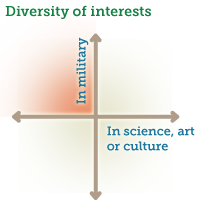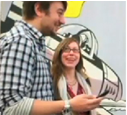There are gender wars, and then there are casualties. It wasn’t until 2011 that the behemoth toymaker LEGO acknowledged girls’ desire to build with bricks, even though the company had long before made a seemingly effortless pivot to co-branding, video games, and major motion pictures. So it’s little wonder that girls face all-too-real obstacles when […]
Read moreSearch Results for:
 National security is a useful angle for presenting science, art and culture issues to disengaged or skeptical audiences.
National security is a useful angle for presenting science, art and culture issues to disengaged or skeptical audiences.
 Like any hook, such as sports or popular culture, military and national security themes broaden an audience for outreach. There are over 3.6M military personnel in the U.S., 1.9M spouses & kids of active duty members, and over 22M veterans, who also have families. (Stats on personnel & families, and veterans.)
Like any hook, such as sports or popular culture, military and national security themes broaden an audience for outreach. There are over 3.6M military personnel in the U.S., 1.9M spouses & kids of active duty members, and over 22M veterans, who also have families. (Stats on personnel & families, and veterans.)
There are several initiatives which are bridging the military world with the sciences and culture…
(more…)
 Games on mobile devices are a new way to engage museum visitors. Two companies gave presentations at yesterday’s Museums & Mobile 2011 online conference.
Games on mobile devices are a new way to engage museum visitors. Two companies gave presentations at yesterday’s Museums & Mobile 2011 online conference.
One popular type of game is a miniature scavenger hunt, called “location-gaming.” The premise is that players go places (e.g., a restaurant or park), do fast, simple tasks (like typing something into their phone, or uploading a photo of something), and win a reward (the reward can virtual “points,” or something tangible, like a free postcard or sandwich). Other types of games are more thematic, such as creating playing-card “battles” between characters that appear in art. (more…)
 Museums are going mobile, and many companies are eager to help. At yesterday’s Museums & Mobile 2011 online conference, several vendors promoted their wares. This is a summary of products, approaches, and some alternatives… (more…)
Museums are going mobile, and many companies are eager to help. At yesterday’s Museums & Mobile 2011 online conference, several vendors promoted their wares. This is a summary of products, approaches, and some alternatives… (more…)
 Walking over rough sandstone blocks, between adobe houses, our $20/person tour wove through the streets and alleys of a small village atop a mesa in the Acoma Pueblo, in New Mexico.
Walking over rough sandstone blocks, between adobe houses, our $20/person tour wove through the streets and alleys of a small village atop a mesa in the Acoma Pueblo, in New Mexico.
The tour culminated in the local church (at right), the San Esteban del Rey Mission, which is a source of great pride, and also a symbol of Catholic persecution of traditional peoples. The earthen walls are many feet thick, and the roof is supported by centuries-old logs. (more…)
 On Twitter, almost no one hears you. Or at least that’s the case for 99.95% of Twitter users whose Tweets evaporate into the aether, scrolling off the feed, leaving scarcely a trace.
On Twitter, almost no one hears you. Or at least that’s the case for 99.95% of Twitter users whose Tweets evaporate into the aether, scrolling off the feed, leaving scarcely a trace.
According to statistics released last week by Twitter, users now send a billion Tweets a week (up nearly 3x from 350M a year ago). But most of those Tweets get little attention, reports a new study, to be presented next week at a web conference in India. The study found that attention is highly concentrated among a very narrow slice of Twitter users. Read on for more about the findings…
(more…)

The term “strategic communications” has become popular over the last two decades. It means infusing communications efforts with an agenda and a master plan. Typically, that master plan involves promoting the brand of an organization, urging people to do specific actions, or advocating particular legislation.
It can refer to both a process, and to a specific job title.
 Small differences have a big effect when trying to coax thousands or millions of people. This includes urging online readers to take an action. This post looks at how IDEA used small ads on one of our projects (a small, free web-based exhibit about Daylight Saving Time) to promote another project (a 99¢ app about Daylight Saving Time sold via the Apple app store). This post looks at statistics and ratios… (more…)
Small differences have a big effect when trying to coax thousands or millions of people. This includes urging online readers to take an action. This post looks at how IDEA used small ads on one of our projects (a small, free web-based exhibit about Daylight Saving Time) to promote another project (a 99¢ app about Daylight Saving Time sold via the Apple app store). This post looks at statistics and ratios… (more…)
 The growing field of digital humanities is hampered by a lack of motivation to share tools, and a lack of direct rewards from the academic establishment, says a new study published last month in the Digital Humanities Quarterly.
The growing field of digital humanities is hampered by a lack of motivation to share tools, and a lack of direct rewards from the academic establishment, says a new study published last month in the Digital Humanities Quarterly.
Digital humanities uses computers as part of research in arts and humanities. Computers are useless in isolation; they need software written to do interesting analyses. Some processing can be done using simple text processing tools to sort and count words. More complex research requires new tools (new computer programs) to be created. The study looked at the people who create those new tools. One key finding was that creating new software does little to help researcher’s careers.
 When web sites invite commenting, they open the door to unwanted comments. By quickly identifying types of unwanted comments, you know which comments to delete quickly, which to consider responding to, versus which are part of a healthy community.
When web sites invite commenting, they open the door to unwanted comments. By quickly identifying types of unwanted comments, you know which comments to delete quickly, which to consider responding to, versus which are part of a healthy community.
The following are common species of unwanted comments…


 This weekend, I was a judge at a local chapter of
This weekend, I was a judge at a local chapter of